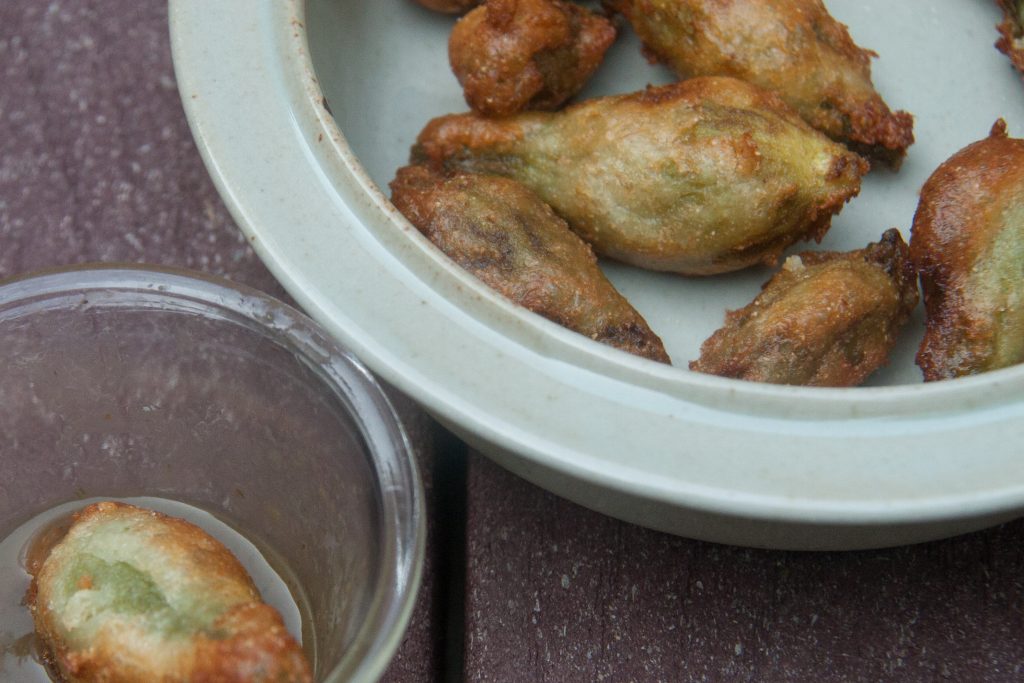
You know how mothers aren’t supposed to have favorite children? (But we know they do, right, Mum?) Fortunately the same rules don’t apply to foragers. I’m often asked what my favorite wild edible plant is, and I don’t hesitate to answer: milkweed.
Milkweed is an edible superstar in my book, providing four edible parts: shoots, flower buds, flowers, and immature seed pods. Of course harvest times will vary depending on where you live and forage, but where I am, milkweed pod season is just beginning and I plan to enjoy every minute of it with these deep fried milkweed pods.
In the past I’ve used the pods in soups and stews, and I’ve even given pan frying a whirl. But this year I decided to break out the Fry Daddy and I’m never looking back. Oh. So. Good.
And the method couldn’t be simpler.
Blanch your milkweed pods in boiling water for 2-3 minutes, until they turn bright green. They’ll poof up and some may even pop and deflate. All of this makes no nevermind.
Rinse the pods in cold water to stop the cooking and let them drain. They’ll hold the batter better if they dry a little. I suggest leaving them in a colander on the counter while you go for a dip in the lake and get out of the hot kitchen.
Plug in your Fry Daddy and fill it with several inches (2-3) of vegetable oil. If you have a fancier deep fryer with a thermostat, set it for 350F. I don’t, and it worked just fine.
Prepare a batter by combining equal parts corn meal and self-rising flour, with a dash of salt and enough buttermilk to make it slightly thicker than pancake batter. Then add a schlug of seltzer to bring it to pancake batter thickness. (I promise I’ll get specific amounts next time I do this, but for now, these approximations will have to do!)
Dip each milkweed pod into the batter to fully coat the pod. Set the battered pods aside and test the oil to see if it’s hot enough. When a bit of batter starts to bubble and fry immediately on contact with the oil, you’re good to go.
Add 4-5 pods to the oil and let them cook until golden brown. (I have a small fryer; yours might handle a bigger batch.) This will be surprisingly quick. Depending on the temperature of your oil it shouldn’t take more than 3-4 minutes per batch. Rest the cooked pods on paper towels to absorb excess oil, and continue to fry your pods in batches until they’re all done.
Serve fried milkweed pods hot as an appetizer or vegetable course, with a dusting of sea salt, or dipped in the sauce of your choice. I used a green chile onion dipping sauce, which was superb, but I’m sure they’d be equally delicious with any number of sauces. In fact, with deep fried milkweed pods, I’m pretty sure you can’t go wrong.
Any milkweed? I have swamp milkweed but the bods have milkweed bugs on them…
Sadly, no, not any milkweed. I think you may have Asclepias incarnata and I can’t speak to its edibility. It might be…but I haven’t tried it. Most foragers harvest common milkweed (A. syriaca) although I suspect experimentation might reveal that other species are also edible. So don’t worry about the bugs!
I just read that common milkweed is poisonous, is that wrong?
That’s a very general statement. If the author meant Asclepias syriaca and said that A. Syriaca is poisonous to humans when cooked then I’d say yes, that’s wrong. Of course individuals can have allergic reactions to foods but calling something poisonous implies that it will kill you or make you sick. Properly prepared, milkweed will do neither of those things to most people. Please tell me where you read that; I’d like to read the article.
I’m not Sue, but until this year, I also thought milkweed was poisonous, because EVERYTHING I’ve ever read about milkweed mentions how poisonous it is. If you google ‘is milkweed poisonous?’, every result on the first page seems to confirm that it is poisonous, especially to animals.
http://homeguides.sfgate.com/poisonous-milkweed-humans-74425.html
That article says there are 76 varieties in the US, of varying toxicity, and even common milkweed can be dangerous if prepared improperly. Given all that information, you’ll have to forgive people if they not only:
Believe milkweed is poisonous
but also
Don’t consider it worth the risk of mis-identification or mispreparation.
Gosh golly dang though, those fried pods make my mouth water. I’m not going to try them, but they look sooooo good.
I’ve heard it can be toxic to livestock, but I have no expertise there. I can tell you that not one of the many people I’ve fed milkweed to has ever had a problem. I know one person who threw up after eating a raw pod. As you mentioned, proper preparation is key. I’d never recommend eating it raw, not only for that reason, but also because it doesn’t taste good that way! Many foragers, myself included, believe the reason people think Asclepias syriaca is poisonous is because they’ve misidentified Apocynum cannibinum (aka dogbane). The two plants look similar when young but the differences are clear once you’ve had them pointed out to you. However, a beginning forager might easily mistake young dogbane shoots for milkweed shoots. And dogbane is indeed bitter and toxic.
My property is filled with edible items and to date have only been using the berries
Last night I decided to give the milkweed pods a try.
even after the concerns of safety from others….
WOW!!!! they are absolutely worth the time😊 after a little research it turns out the blanching is part of the process to make them safe to eat. You would have to eat a LOT of pods dripping the milky sap to get into trouble.
Thank you so much for sharing